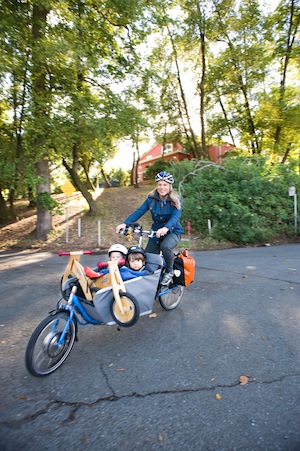The Public Press will soon be getting into the cargo bike business with our Pedal-Powered News Kickstarter campaign. We thought it would be a good idea to learn more about the field, so we talked to Liz Canning, a filmmaker and animator based in Fairfax, California, about “Less Car More Go,” her crowd-sourced documentary about the birth and boom of the cargo bike, for which she’s currently raising funds.
The following interview has been edited and condensed. Photo courtesy of Liz Canning.
 Can you tell us a bit about the history of cargo bikes?
Can you tell us a bit about the history of cargo bikes?
The first cargo bikes were made over a hundred years ago in Northern Europe, where they were a big deal. They caught on here for a little while around the turn of the century, and even in the 1950s there were a lot of delivery bikes, but they disappeared once we started using cars. The Xtracycle was invented around 1995, and they tried really hard to get it to catch on here, but it just didn’t. It wasn’t until around 2006, 2007 that cargo bikes started to come back.
Why now?
I think it was partly rising gas prices, awareness of climate change issues and even the economy tanking.
Where in the country are we seeing the cargo bike movement taking off?
It’s happening mostly in the bike-friendly cities: the Bay Area, Portland, where they’ve been doing it for a long time, and even places like New York and Chicago.
Are there ways that cities can make it easier for people to use cargo bikes?
Yes, and I think that the major cities are all working on bike infrastructure right now. There’ve been some laws passed that have made a lot more money available for bike infrastructure, and I think it’s going to get better and better.
Another really exciting thing that’s about to happen in the Bay Area is that City CarShare is going to add electric cargo bikes to their program. Cargo bikes are expensive, but once people try it — especially with electric assist — they see that it’s easy, and anyone can do it. So I think having a bike share program where it’s available for people to just try is going to be great.
How does electric assist work?
With electric assist, you have a motor that goes in the hub of your wheel, and then a battery someplace else on the bike. There are different kinds of systems, but mine, for example, is straddle-activated. I use it whenever I need a little boost to get up a hill, or if I’m carrying four kids. It makes riding a cargo bike much more fun and doable, so that you never really have an excuse. You might be tired, you might not want to get sweaty, you might be picking up a lot of stuff along the way, but with electric assist, there’s no reason not to take the bike, really.
How did you get into cargo bikes?
I’ve always loved my bike, I was never into driving and I loved riding everywhere around the Bay Area. It was hard when I had my kids and realized that I couldn’t get them up our hill anymore. So I started looking around on the Internet and I found this cargo bike. We bought it pretty quickly and immediately realized that it was a huge benefit to us. Then, once we got the electric assist, I realized that this was not just for hardcore cyclists. Anybody could really benefit from this.
How did the idea for “Less Car More Go” come about?
We got the bike four years ago and the electric assist nine months after that. I’d had the motor for a few months, and was realizing through spending time online how many blogs there were. People were writing about how their cargo bikes had enhanced their lives and I kept on talking about the idea until my husband said, “you just have to do this, you can’t drop it.”
What about cargo bikes makes people so excited?
There’s so much of our daily life when I think we’re aware that we’re compromising ourselves. To me, it’s like when you get on a bike, everything about it feels right — it’s good for your body, it’s good for the environment, it’s good for your kids if they’re with you. Riding with kids is totally magical.
It’s a really contagious feeling, and I think that’s why the connections between cargo cyclists are so intense. There are a lot of groups, and they are really supportive of each other. It’s something that we all want to see more people doing. The support for the project and for the Kickstarter has been amazing.
What are some of your favorite stories?
Well, of course, there’s Emily Finch, the mom who carries six kids on her bike in Portland. It’s unbelievable. Her bike with all the kids on it probably weighs over 600 pounds. She actually used to drive a nine-passenger suburban in Pennsylvania, but became concerned about peak oil and started thinking about a new way of transporting her kids. At the time, in Pennsylvania, people thought she was insane. She moved to Portland partly because she realized that she just didn’t want to drive anymore.
Another family, Stacy Bisker and Brent Patterson, had four kids and a lot of student debt, and decided purely for financial reasons to get a cargo bike. They were not bike people and now they are so all over it. They don’t have any cars. They had to move to Buffalo, New York and they got through the whole winter without using a car.
The bike people will come, they’ll be interested, but this isn’t going to take off unless we expand our notion of what bike people are. Mikael Colville-Andersen talks a lot about how the main obstacle with many of the Anglo-Saxon countries is that bikes have been a toy or a recreational vehicle for so long. People really think of it as something that you do for sport. They don’t take it seriously as a practical solution to many problems.
Are you seeing a lot of businesses switching over?
It’s slow-going in this country. George Bliss, who’s kind of a big deal in the history of cargo bikes in New York — he owned a pedicab business and now he owns a cargo bike shop — he talks about how there’s sort of a romanticism involved with being a bike messenger, there’s sort of the cool factor, but once you put a lot of weight on a bike, it’s sort of a grubby job. So it’s going to take somebody like Whole Foods, some big chain getting a fleet of electric-assist cargo bikes or trikes and doing a lot of their business that way, and then it will catch on.
In Europe, for example, the European Cyclists Federation has this group called Cycle Logistics. It’s a collaboration between representatives from about nine different European cities, all of which are really congested and built obviously before the automobile. What they’re trying to do is get the last part of a delivery run — the intra-city delivery — all done on cargo bikes, so there’s a lot of businesses there starting to use bikes. It’s happening there for sure.
Would you like a newspaper delivered by cargo bike?
Out here [in Fairfax], that person would have a real workout, but in San Francisco, absolutely. I think that’d be so cool.
Check out Liz’s Less Car More Go Kickstarter Campaign
Check out the Public Press’ Pedal-Powered News Kickstarter Campaign










